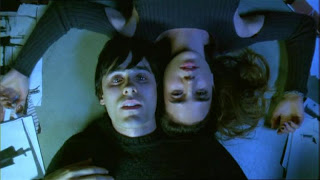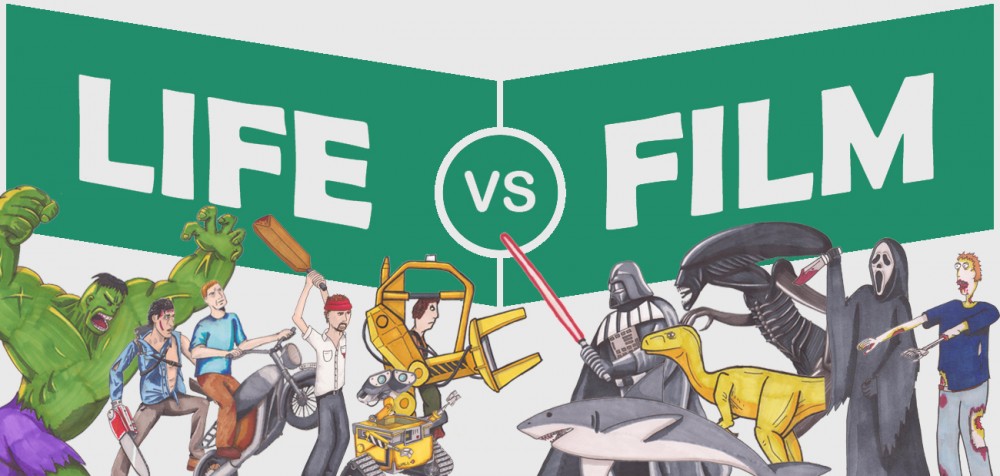A young prince, Ashitaka (Billy Crudup), defends his home by killing a giant boar-god that has been corrupted by a monstrous force and turned into a demon, but in the process Ashitaka finds himself infected on his right arm. His only chance at survival is to be exiled from his city – to which he can never return – and seek the Spirit of the Forest and ask for forgiveness. However, when Ashitaka finds the forest, he uncovers a war between a nearby town, led by Lady Eboshi (Minnie Driver) and the animals and gods of the forest, led by the wolf-goddess Moro (Gillian Anderson) and her adopted human daughter San (Claire Danes), who is known to the townspeople as Princess Mononoke. In order to achieve the help of the Spirit of the Forest, Ashitaka must help resolve the conflict between the two factions, neither of whom seem to want his help.
 Continue reading
Continue reading
Tag Archives: Keith David
Platoon
 Charlie Sheen is Chris Taylor who, after dropping out of college because he wasn’t learning anything, volunteers to fight in the Vietnam war, amongst recruits including Keith David, Forest Whittaker, Tony Todd, Kevin Dillon and a young Johnny Depp. The platoon is split, with half drawn to Willem Dafoe’s free-thinking, laidback stoner Sergeant Elias, with the rest, including brown-nosing Sergeant O’Neill (John C. McGinley), prefer the ethos of scarred Staff Sergeant Barnes (Tom Berenger), who counts success by how high the bodies are piled, rather than whether peace has been achieved.
Charlie Sheen is Chris Taylor who, after dropping out of college because he wasn’t learning anything, volunteers to fight in the Vietnam war, amongst recruits including Keith David, Forest Whittaker, Tony Todd, Kevin Dillon and a young Johnny Depp. The platoon is split, with half drawn to Willem Dafoe’s free-thinking, laidback stoner Sergeant Elias, with the rest, including brown-nosing Sergeant O’Neill (John C. McGinley), prefer the ethos of scarred Staff Sergeant Barnes (Tom Berenger), who counts success by how high the bodies are piled, rather than whether peace has been achieved.Requiem for a Dream
 DON’T DO DRUGS. There you go, just saved you an hour and three quarters. Except that’s just the thing, although this film can be summed up in just three little words, it’s still an exceptional piece, just thoroughly depressing and cautionary. Easily the reason I’ve never so much as even picked up a joint, this film should be mandatory viewing in schools and rehab centres the world over, with every step taken by the four leads taking them further down a spiral they really don’t want to see the end of. Firstly, there’s Jared Leto’s slacker Harry, living day-to-day by repeatedly stealing and selling his doting mother’s television with best friend Tyrone (Marlon Wayans, surprisingly good) in order to buy drugs. Harry’s girlfriend Marion (Jennifer Connelly) is a promising fashion designer, but occasionally must turn tricks when money runs low, and Harry’s mother Sara (Ellen Burstyn, Julia Roberts has your Oscar) lives alone, glued to her television, unable to deal with the direction her son has taken.
DON’T DO DRUGS. There you go, just saved you an hour and three quarters. Except that’s just the thing, although this film can be summed up in just three little words, it’s still an exceptional piece, just thoroughly depressing and cautionary. Easily the reason I’ve never so much as even picked up a joint, this film should be mandatory viewing in schools and rehab centres the world over, with every step taken by the four leads taking them further down a spiral they really don’t want to see the end of. Firstly, there’s Jared Leto’s slacker Harry, living day-to-day by repeatedly stealing and selling his doting mother’s television with best friend Tyrone (Marlon Wayans, surprisingly good) in order to buy drugs. Harry’s girlfriend Marion (Jennifer Connelly) is a promising fashion designer, but occasionally must turn tricks when money runs low, and Harry’s mother Sara (Ellen Burstyn, Julia Roberts has your Oscar) lives alone, glued to her television, unable to deal with the direction her son has taken.
 The film is at times incredibly hard to watch (double-ended dildo, anyone?) but when you do it’s nothing short of a cinematic goldmine, with director Darren Aronofsky’s editing and Clint Mansell’s spot-on score fitting the addiction-addled characters lives perfectly. Fish-eye lenses, split-screen, sped-up/slow-down footage and cameras strapped to actors focussed on their faces as they flee from the mess they’re in are all used perfectly. Compare this to Happy Together, where these same devices were used just for the sake of it, to show the director could, and you can really see how relevant they are here. Also, compare the editing, especially that of drug hits; rapid shots of syringes depressing and eyes dilating, with similar edits in Edgar Wright’s Shaun of the Dead. The two use very similar techniques, but with wildly different effects.
The film is at times incredibly hard to watch (double-ended dildo, anyone?) but when you do it’s nothing short of a cinematic goldmine, with director Darren Aronofsky’s editing and Clint Mansell’s spot-on score fitting the addiction-addled characters lives perfectly. Fish-eye lenses, split-screen, sped-up/slow-down footage and cameras strapped to actors focussed on their faces as they flee from the mess they’re in are all used perfectly. Compare this to Happy Together, where these same devices were used just for the sake of it, to show the director could, and you can really see how relevant they are here. Also, compare the editing, especially that of drug hits; rapid shots of syringes depressing and eyes dilating, with similar edits in Edgar Wright’s Shaun of the Dead. The two use very similar techniques, but with wildly different effects.The Thing
 Arguably surpassing Howard Hawk’s 50s sci-fi classic the Thing from Another World (a feat unlikely to be achieved by the imminent Mary Elizabeth Winstead starring prequel, confusingly also named ‘The Thing’), John Carpenter’s Thing deserves its place on the list for Rob Bottin’s effects work, occasionally assisted by the legend that is Stan Winston.
Arguably surpassing Howard Hawk’s 50s sci-fi classic the Thing from Another World (a feat unlikely to be achieved by the imminent Mary Elizabeth Winstead starring prequel, confusingly also named ‘The Thing’), John Carpenter’s Thing deserves its place on the list for Rob Bottin’s effects work, occasionally assisted by the legend that is Stan Winston.There’s Something About Mary/Dumb & Dumber
 Say what you will about directing brothers Peter & Bobby Farrelly (Kingpin, Me, Myself & Irene, Shallow Hal, Stuck on You, Hall Pass), but at times their combination of prat-falls, worst case scenarios, extreme gross-out humour and stellar casts of ensemble comic actors can occasionally work out well, with these two films being pick of the bunch.
Say what you will about directing brothers Peter & Bobby Farrelly (Kingpin, Me, Myself & Irene, Shallow Hal, Stuck on You, Hall Pass), but at times their combination of prat-falls, worst case scenarios, extreme gross-out humour and stellar casts of ensemble comic actors can occasionally work out well, with these two films being pick of the bunch.  The humour may go a tad too far for some) laxatives, urine drinking, masturbation and an excruciating penis-in-zipper-moment), but by ensuring their actors play the roles straight, and staying just the right side of plausibility make sure these films serve their intended purpose, as light-hearted comedy. If anything, it’s the small moments that make these films excel, be it a disc-sanding pedicure in Dumb & Dumber or the infamous spunked-up hair-do in Mary, as well as simple yet spot-on puns and wordplay (“a rapist wit”), and the casting is such that the central actors could not be replaced without seriously jeopardising the characters they play. So yes, the Farrellys have made some duffers in their time, but they’re worth enduring if occasionally they crap out gold like this.
The humour may go a tad too far for some) laxatives, urine drinking, masturbation and an excruciating penis-in-zipper-moment), but by ensuring their actors play the roles straight, and staying just the right side of plausibility make sure these films serve their intended purpose, as light-hearted comedy. If anything, it’s the small moments that make these films excel, be it a disc-sanding pedicure in Dumb & Dumber or the infamous spunked-up hair-do in Mary, as well as simple yet spot-on puns and wordplay (“a rapist wit”), and the casting is such that the central actors could not be replaced without seriously jeopardising the characters they play. So yes, the Farrellys have made some duffers in their time, but they’re worth enduring if occasionally they crap out gold like this.